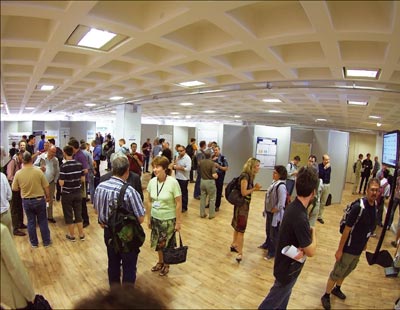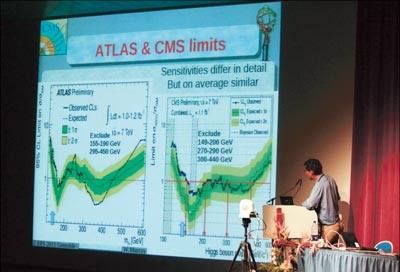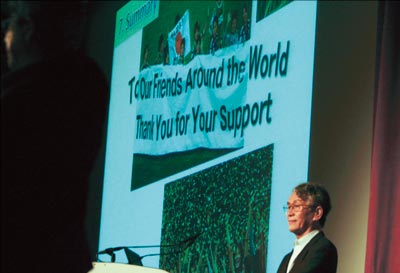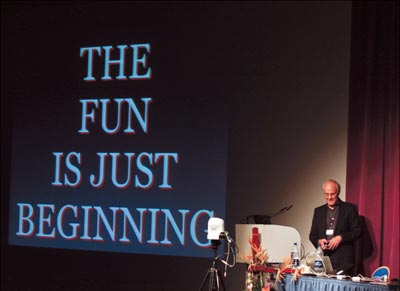Highlights from the EPS-HEP 2011 meeting.

Image credit: Tomáš Ježo/LPSC.
The biennial meetings organized by the High Energy and Particle Physics division of the European Physics Society (EPS) aim to provide a global view of the state of the art in research in the field. This year’s meeting, which took place in Grenoble on 21–27 July, attracted more than 800 participants – and certainly delivered. The International Europhysics Conference on High-Energy Physics, EPS-HEP 2011, was the first major international conference since CERN’s LHC started to supply significant amounts of data in a new energy region. After only one year of data-taking, the LHC took centre stage, in both proton–proton and heavy-ion physics, thanks to the spectacular performance of the accelerator and the impressively fast data analysis by the experiments. In parallel, there were results based on near-final data samples from experiments at Fermilab’s Tevatron and at the B factories, while hot news came from neutrino experiments and searches for dark matter. All in all, the conference was a real success, raising current knowledge up a huge notch across all searches for new physics.
All of the Tevatron and LHC experiments showed improved or new limits in searches, reaching mass limits close to or slightly above 1 TeV in simple supersymmetric models. Anyone who had hoped that the LHC would reveal supersymmetry early on may have been slightly disappointed, but as many theorists reminded the participants: new physics is guaranteed, all that is needed is patience. CERN’s director-general, Rolf Heuer reinforced this point, stating that either finding the Higgs or excluding it will be a great discovery.
At the Tevatron, the CDF and DØ experiments – with data corresponding to an integrated luminosity of about 8 fb–1 – continue to extend their exclusion limits for a Higgs particle with a mass of around 160 GeV. After two decades of truly fruitful physics, the Tevatron was scheduled to shut down definitively at the end of September, leaving a total of more than 10 fb–1 of data ready to be analysed. Meanwhile, the CMS and ATLAS experiments at the LHC have already reached a sensitivity exceeding that of the Tevatron experiments. Both experiments have slightly better preliminary limits in the region covered by CDF and DØ, while also excluding a high-mass Higgs – in a region out of the reach of the Tevatron. Most amazingly, if the LHC continues to perform as well as it has so far, the experiments are guaranteed to find or exclude the Standard Model Higgs by the end of 2012.
There was, however, already some intriguing news from the Higgs sector. Both the CMS and ATLAS collaborations revealed small excesses of events in their preliminary WW and ZZ analyses based on about 1 fb–1 of data. The most significant upward fluctuation over background was obtained in the Higgs → WW → |ν|ν channel. Both groups also see smaller excesses in the same mass region from the decay via ZZ to four leptons. All of these fluctuations fall in regions that are not yet excluded by the Tevatron or the LHC, and they made for some interesting discussions during the conference. If the Standard Model Higgs boson does indeed exist, this is exactly how it will manifest itself: a faint appearance above the distant horizon, which should grow with time as more data are analysed. Nonetheless, everyone agreed that it is far too early to tell what is happening unambiguously before more data are added and further rigorous checks made, because both experiments could be affected similarly by mis-modelling of the background or be victims of statistical fluctuations.

Image credit: Jiͅí Kvita/CERN.
The recent results from CDF, CMS and LHCb on the flavour-changing neutral-current decays Bs → μμ provided another great conversation topic. The CDF collaboration reported a first measurement of this branching ratio at (1.8 + 1.1 – 0.9) × 10–8, which is higher than the Standard Model prediction of (3.2 ± 0.2) × 10–9. On the other hand, CMS and LHCb both have preliminary limits, which when combined are lower than the CDF result. More data from all experiments will soon help to clear this ambiguity.
One analysis that has drawn considerable attention in the preceding months is CDF’s observation of a possible signal of new physics in the final state W + 2 jets. The updated analysis, now based on 7.3 fb–1 of data, shows a clear excess of events with a dijet mass around 145 GeV. At more than 4σ, this is a significant excess, shared equally between the two channels W → e or μ. All eyes have thus turned to DØ, which is best positioned to look into this effect. The DØ team performed an important verification by artificially adding in a signal such as the one that CDF observed to confirm that DØ is indeed sensitive to such a signal. All efforts so far have turned up no excess above Standard Model backgrounds in a 4.3 fb–1 data sample, even when emulating the CDF selection criteria. A joint task force between the two experiments is now hard at work trying to resolve this discrepancy. Meanwhile, at the LHC, a similar signal would have to emerge amid larger backgrounds, so the sensitivity in this search may be diminished, depending on the nature of the new effect. Both CMS and ATLAS are actively combing through their data for signs of this effect, finding no evidence for the CDF signal thus far.
The DØ and CDF collaborations still see a deviation from the Standard Model in the forwards–backwards asymmetry of top–antitop production, opening the door to several possible explanations in terms of physics beyond the Standard Model. This effect is most pronounced at tt masses above 450 GeV. More studies are underway.
From QCD to neutrinos
The session on QCD showed great progress in the field, with updates on parton distribution functions from the experiments at DESY’s HERA collider, which stopped running in June 2007, as well as several results from the LHC. These measurements are now challenging the precision of theoretical predictions and will contribute to further refinements of the Monte Carlo simulations.

Image credit: Jiͅí Kvita/CERN.
On the flavour front, there were as many as 25 new results from near-to-final datasets in the BaBar and Belle experiments at the B factories at SLAC and KEK, respectively, as well as new measurements from the Tevatron and LHC experiments, in particular LHCb. Together, they provide significant tests of the Standard Model, which still stands strong and unchallenged despite every attempt to uncover a flaw. Searches for charged-lepton flavour violation, electric dipole moments and the updated dilepton charge-asymmetries at the Tevatron continue to probe possible new effects. The BaBar collaboration showed impressive limits on rare decays with branching ratios reaching as low as 10–8, while LHCb now has the most precise single measurement and first 5σ observation of CP violation at a hadron machine using B→Kπ decays.
Any deviation from the Standard Model predictions would reveal the existence of new physics, but such deviations now require even more stringent tests, hence more data are needed. To collect even larger data samples, a new generation of B factories is on its way. The Belle II experiment at SuperKEKB is well into the construction phase and will replace KEKB, which shut down definitively in June 2010. The SuperKEKB design luminosity of 8 × 1035 cm–2 s–1 is 40 times higher than the record for KEKB. Commissioning of the upgraded machine and experiment is planned for mid-2014. Meanwhile, the SuperB project has been approved in Italy. Parts of the BaBar detector will soon cross the ocean to be relocated in Rome at a new facility on the Tor Vergata University campus, to start a new life there in 2015.
As ever, conference participants eagerly anticipated news from the various direct searches for dark matter. While both the DAMA/LIBRA and CoGeNT experiments have tantalizing signs of light dark-matter candidates, these are now in contradiction with recent limits revealed by the XENON100 collaboration, whose null results exclude the first two results. Hence, the situation remains ambiguous, with much still to be elucidated. Efforts are ongoing to explain why the peaks of the modulation signals seen by DAMA/LIBRA and CoGeNT do not coincide. Further scrutiny is also being directed towards the unmodulated part of the DAMA/LIBRA signal, together with investigations of other possible backgrounds for the CoGeNT experiment – all with the aim of producing more convincing and irrefutable results. The whole community is hard at work collecting and analysing more data, while construction of larger detectors that will use a tonne or more of active material is underway. With new results and updates expected in a year or two, this topic will be among the highlights of the next EPS-HEP meeting in 2013.
The 295 km Tokai-to-Kamioka (T2K) long-baseline neutrino experiment in Japan, and the Fermilab-based Main Injector Neutrino Oscillation Search (MINOS) with a “far” detector 730 km away in the Soudan Mine, now have the first indications for a sizeable mixing angle between the electron and muon neutrinos. These measurements were discussed in view of their implications for the measurement of CP violation in neutrino mixing and for the design of future long-baseline neutrino projects. One of the proposed experiments, the Laguna Pyhäsalmi project, would have an underground 100 ktonne “far” detector in Finland, 2300 km from CERN. Its goal would be to measure neutrino oscillations, taking advantage of large enhancements from matter effects.

Image credit: Jiͅí Kvita/CERN.
While the LHC is already looking back in time all of the way to the early universe, it will also take particle physics into the future, with plans established up to 2030 and beyond. Three long shutdowns are currently foreseen. The first will take place at the end of 2012 to allow improvements in the magnet interconnects and for the installation of new release-valves to ensure the prevention of further incidents like the one that brought the LHC to a halt in 2009. This will allow the machine to reach its design centre-of-mass energy of 14 TeV by the autumn of 2014. The following long shutdown in 2018 will be for several detector upgrades while the final planned shutdown, in 2022, will be used to prepare for the high-luminosity upgrade to the LHC (HL-LHC). Scenarios are also being considered for an upgrade to higher energies in the even more distant future.
A next-generation linear collider is still under study, with final design reports on the Compact Linear Collider (CLIC) and International Linear Collider (ILC) concepts planned for the end of this year. The physics outcome from the LHC experiments by the end of 2012 will provide crucial input to decide what kind of linear collider will best suit the future needs of particle physics.
On the theoretical front, participants heard of recent accomplishments using scattering amplitudes in quantum field theory. As well as updating the community on their progress with calculation techniques, the presentations by theorists served as a reminder that the questions that are currently unanswered by the Standard Model – from the existence of dark matter to the unexplained problem of particle “generations” – imply that new physics ought to be there, waiting to be discovered.
The closing session was devoted to an outlook for experimental and theoretical particle physics as a whole. Pier Oddone, Rolf Heuer and Atsuko Suzuki, the directors for Fermilab, CERN and KEK, respectively, presented their visions for the future of particle physics from the perspectives of the US, Europe and Asia.
Oddone laid out the many plans for Fermilab in the post-Tevatron era, spanning from searches for dark energy and dark matter, to neutrino physics with upgraded experiments MicroBoone and MINOS+, as well as projects for accelerator development of the ILC and a muon collider. He reminded participants that contributions to the LHC from the US – for both the accelerator and the detector – represented the largest single investment in high-energy physics that the US has made since the 1970s.
Suzuki warmly thanked the community for its extended support after the devastating earthquake and tsunami earlier this year and it was moving to hear about the efforts that Japanese colleagues are making to recover from the effects. The KEK laboratory suffered damage both at the Tsukuba and Tokai campuses. Nevertheless, the construction plans for SuperKEKB are still on schedule. Repairs are underway at Tokai, with the first power tests scheduled for November. In addition, Suzuki presented new projects underway in Asia, such as the Korea Neutrino Research Center, which was scheduled to start operation in August, and the Daya Bay experiment in China, which will study oscillations in reactor neutrinos. “Near” detectors at Daya Bay started data-taking in August, while “far” detectors in the nearby mountains should be operating by next summer.
We have one inverse femtobarn of data in, and 2999 more to go. So be patient. The fun is just starting!
David Gross
Heuer stressed both the importance of international collaboration in establishing any future accelerator projects and how the results of existing facilities should be used to determine the needs for future accelerators. Results from the LHC will therefore be a key ingredient in determining which design is best for a new linear collider. In an effort to increase the collaborative spirit, CERN is already opening its door to new member states.
All of the great results presented at EPS-HEP 2011 could not have been fully appreciated without the impeccable organization provided by the local committee headed by Johann Collot of the University of Grenoble. Sometimes, however, success can bring trouble: interest in the conference following the news of intriguing reports on the Higgs boson nearly brought the conference website to a halt.
The local committee also spared no effort in treating the participants to local specialities, providing more than just food for thought. These included an impressive wine-and-cheese reception on the opening night, followed by “danced” lectures organized for the public. While local speakers explained the field of particle physics, dancers from the University of Grenoble’s modern-dance company accompanied them on stage, seemingly surprising some of the speakers themselves. The evening ended with a beautiful “dance of the particles” to everybody’s delight. The social programme also included a soccer tournament, a reception hosted by the City of Grenoble at the modern art museum, a Bel Canto concert and a gastronomic dinner – enough to suit everyone’s taste.
This conference really marked the beginning of the LHC era. As David Gross, who received the Nobel Prize in Physics in 2004, concluded: “We have one inverse femtobarn of data in, and 2999 more to go. So be patient. The fun is just starting!” Now, even the unexpected can be expected.
The EPS-HEP awards

Image credit: Tomáš Jezcirco/LPSC.
A key highlight was the presentations of prizes by the High Energy and Particle Physics Division of the EPS. This year the prestigious High Energy and Particle Physics Prize for an outstanding contribution to High Energy Physics went to Sheldon Lee Glashow of Boston University, John Iliopoulos of the Ecole Normale Supérieure, Paris, and Luciano Maiani from the University of Rome La Sapienza. They were rewarded “for their crucial contribution to the theory of flavour, presently embedded in the Standard Theory of strong and electroweak interactions which is still of utmost importance today”. In 1970, they put forward a compelling argument for the existence of a fourth quark – charm – to solve a number of problems in particle physics. Their proposal, now known as the GIM mechanism, was spectacularly confirmed when particles containing the charm quark were unexpectedly discovered in 1974.
The Giuseppe and Vanna Cocconi Prize for an outstanding contribution (experimental or theoretical) to particle astrophysics and cosmology went to Paolo de Bernardis of the University of Rome La Sapienza and Paul Richards of the University of California, Berkeley, “for their outstanding contributions to the study of cosmic microwave background anisotropies with the balloon-borne experiments BOOMERanG and MAXIMA”.
Davide Gaiotto of the Institute for Advanced Studies in Princeton, received the Gribov Medal for outstanding work by an early-career physicist in theoretical particle physics and/or field theory. He was rewarded “for his work on uncovering new facets of the dynamics of four-dimensional supersymmetric gauge theories and in particular for discovering a large class of four-dimensional superconformal theories and for finding with others important intricate relations between two-dimensional theories of gravity and four-dimensional gauge theories”.
The Young Physicist Prize for outstanding work by one or more was awarded to Paolo Creminelli of the International Centre for Theoretical Physics, Trieste, and Andrea Rizzi of the Swiss Federal Institute of Technology, Zurich. Creminelli received his share of the award “for his contributions to the development of a solid field-theoretical approach to early-universe cosmology and for his studies of non-gaussianities in the cosmic-microwave background”, while Rizzi was rewarded “for his contributions to the reconstruction software and physics programme of the CMS experiment at the LHC”.
Finally, the Outreach Prize for outstanding outreach achievement connected with high-energy physics and/or particle astrophysics went to Christine Kourkoumelis of the University of Athens and Sofoklis Sotiriou, director of the Ellinogermaniki Agogi Center for Science Teachers Training, for “building educational resources to bring the research process in particle physics and its results to teachers and students, both nationally and across Europe”.








